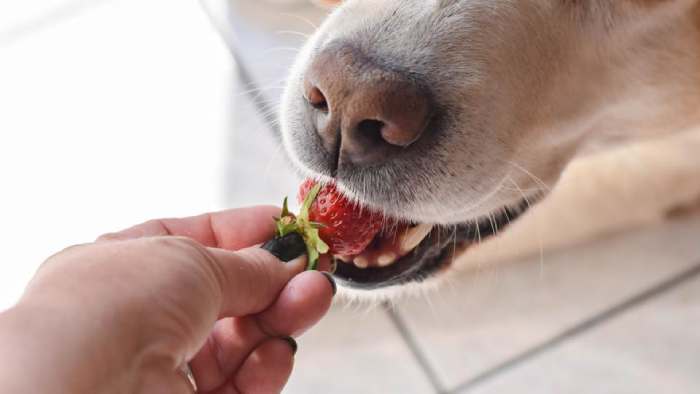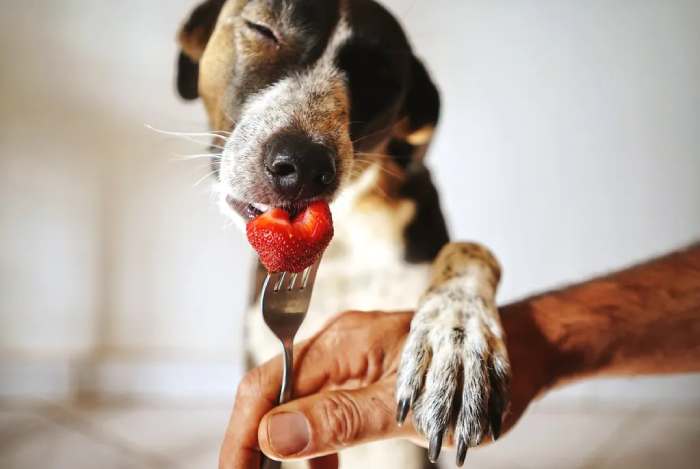Hey there, fellow dog lovers! Have you ever wondered if sharing your delicious strawberries with your four-legged friend is safe? Well, you’re in the right place because I will answer the burning question today: are dogs allowed to have strawberries?
Health Benefits of Strawberries for Dogs:
When feeding our furry friends, we always want to ensure we’re giving them the best. So, you may be wondering, are strawberries safe for dogs? Well, I’ve got some good news for you – strawberries can be a healthy and tasty treat for your four-legged companion!

Strawberries are not only delicious but also offer a range of health benefits for dogs. Here are a few reasons why you might consider sharing some strawberries with your pet:
- Vitamin C Boost: Like humans, strawberries are packed with vitamin C, which can help boost your dog’s immune system. This essential nutrient can help fight illnesses and keep your pup feeling their best.
- Antioxidant Powerhouse: Strawberries contain antioxidants that can help neutralize harmful free radicals in your dog’s body. These antioxidants can contribute to overall health and may help prevent certain diseases.
- Fiber for Digestive Health: Just like us, dogs need to maintain a healthy digestive system. Strawberries are a great source of fiber, which can aid digestion and keep things running smoothly for your pup.
- Natural Teeth Cleaner: Chewing on strawberries can act as a natural tooth cleaner for your furry friend. The texture of the fruit can help remove plaque and tartar buildup, promoting better oral health.
It’s important to note that while strawberries can be a healthy treat, they should always be given in moderation. Too many strawberries could potentially upset your dog’s stomach or cause diarrhea. Additionally, it’s crucial to remove the stems and leaves from strawberries, as they can pose a choking hazard.
So, the next time you’re enjoying a delicious bowl of strawberries, feel free to share a few with your furry companion. Just remember to do so in moderation, and always monitor your dog’s reaction to ensure they tolerate strawberries well.
Now that we’ve explored the health benefits of strawberries for dogs, let’s dive into how to properly introduce strawberries into your dog’s diet in the next section.
Potential Risks of Feeding Strawberries to Dogs:
While strawberries are generally safe and beneficial for dogs, it’s important to be aware of potential risks that can arise from feeding them this fruit. Here are a few factors to consider:
- Allergic Reactions: Just like humans, dogs can develop allergies to certain foods, including strawberries. They may experience symptoms such as itching, hives, swelling, or gastrointestinal issues. If you notice any adverse reactions after introducing strawberries to your dog’s diet, it’s best to consult with a veterinarian.
- Pesticides: Strawberries are among the most heavily sprayed fruits when it comes to pesticides. These pesticides can be harmful to dogs if ingested in large amounts. To minimize the risk, opt for organic strawberries or wash conventionally grown strawberries thoroughly to remove any potential pesticide residues.
- Digestive Upset: While strawberries are generally easy to digest for most dogs, some may experience digestive upset if they consume too many or eat them too quickly. This can result in symptoms such as vomiting, diarrhea, or stomach discomfort. To prevent this, introduce strawberries gradually into your dog’s diet and monitor their reaction.
- Choking Hazard: Although strawberries are small and soft, the stems and leaves can pose a choking hazard to dogs. It’s essential to always remove these parts before offering strawberries to your furry friend. Additionally, make sure to cut the strawberries into smaller, bite-sized pieces for easier consumption.
- Sugar Content: Strawberries contain natural sugars, which can contribute to weight gain and dental issues if consumed in excess. While the sugar content in strawberries is relatively low compared to other fruits, it’s still important to give them to your dog in moderation as part of a balanced diet.
By being mindful of these potential risks, you can safely incorporate strawberries into your dog’s diet and reap the many health benefits they offer without compromising their well-being. Remember, moderation and proper preparation are key when it comes to feeding strawberries to your furry companion.
How do you safely feed strawberries to your dog?

When it comes to feeding strawberries to your dog, safety should always be your top priority. Here are some important tips to follow to ensure that your furry friend can enjoy this delicious fruit without any adverse effects:
1. Introduce strawberries gradually: Before giving your dog a full serving of strawberries, start by offering them a small piece to see how they react. Some dogs may have sensitivities or allergies to certain fruits, so it’s important to monitor their response.
2. Wash the strawberries thoroughly: Like with any fruit, it’s essential to wash strawberries before feeding them to your pet. This helps remove any pesticides or harmful substances that may be present on the surface.
3. Remove the stem and leaves: The stems and leaves of strawberries can pose a choking hazard and may be difficult for dogs to digest. Ensure you remove them before offering the fruit to your dog.
4. Cut the strawberries into small pieces: To prevent choking, it’s best to cut strawberries into bite-sized pieces before giving them to your dog. This makes it easier for them to chew and swallow the fruit safely.
5. Feed in moderation: While strawberries are generally safe for dogs, they should be given in moderation due to their sugar content. Excessive consumption of strawberries can lead to stomach upset and gastrointestinal issues. As a general rule, make strawberries only a small part of your dog’s diet.
Remember, every dog is different, and what works for one may not work for another. Always consult with your veterinarian before making any significant changes to your dog’s diet, including introducing new foods like strawberries.
By following these tips and using common sense, you can safely incorporate strawberries into your dog’s diet and provide them with a tasty and nutritious treat. So go ahead, share the joy of strawberries with your furry friend!
Let’s continue the article with a new section on the “Nutritional Benefits of Strawberries for Dogs”.
Signs of Strawberry Allergies in Dogs:
As I mentioned earlier, strawberries can be a healthy and tasty treat for most dogs. However, just like humans, dogs can have allergies too. It’s important to be aware of the signs of strawberry allergies in dogs to ensure their well-being. Here are some common signs to watch out for:
- Itching and Skin Irritation: If you notice your dog excessively scratching, licking, or biting their skin after consuming strawberries, it may be a sign of an allergic reaction. Allergies can cause itchiness and irritation, leading to discomfort for your furry friend.
- Digestive Issues: Dogs with strawberry allergies may experience gastrointestinal problems such as vomiting, diarrhea, or an upset stomach. If you notice any sudden changes in your dog’s bowel movements after eating strawberries, monitoring their condition is essential.
- Swelling: Allergic reactions can cause swelling, particularly around the face, lips, or throat. If you notice any swelling or difficulty breathing after your dog has ingested strawberries, it’s crucial to seek immediate veterinary assistance.
- Respiratory Symptoms: Some dogs may exhibit respiratory symptoms such as coughing, wheezing, or sneezing after consuming strawberries if allergic. It’s important to observe your dog’s breathing and assess if there are any unusual respiratory symptoms.
If you observe any of these signs after feeding your dog strawberries, it’s best to consult with your veterinarian. They can help determine if your dog is indeed allergic to strawberries or if there might be another underlying cause for their symptoms. Remember, your veterinarian is the best resource for personalized advice based on your dog’s specific needs.
Now that we’ve discussed the signs of strawberry allergies in dogs, it’s important to be cautious when introducing strawberries to your furry friend’s diet.
Conclusion:
Feeding strawberries to dogs can be a safe and enjoyable treat if it is done in moderation and with caution. By introducing strawberries gradually, washing them thoroughly, and consulting with a veterinarian, dog owners can ensure that their furry friends can enjoy the benefits of this delicious fruit without any adverse effects.
It is important to be aware of the signs of strawberry allergies in dogs, such as itching, digestive issues, swelling, and respiratory symptoms. If any of these signs are observed after feeding strawberries to a dog, it is crucial to seek veterinary advice to determine the underlying cause and take appropriate action.
Remember, every dog is unique, and what works for one may not work for another. It is always best to consult with a veterinarian before significantly changing a dog’s diet, including introducing new foods like strawberries.
So go ahead and treat your furry companion to some sweet strawberries, but always prioritize their safety and well-being. With the right approach, dogs can enjoy this tasty fruit as a healthy and occasional treat.

Hey there, I’m Janet Brooks, a dog-loving student from California. I’m all about helping pups in need, especially those without homes. Me and my awesome friends work together to give shelter and love to stray dogs. Oh, and I also write blogs about dogs to share helpful info.